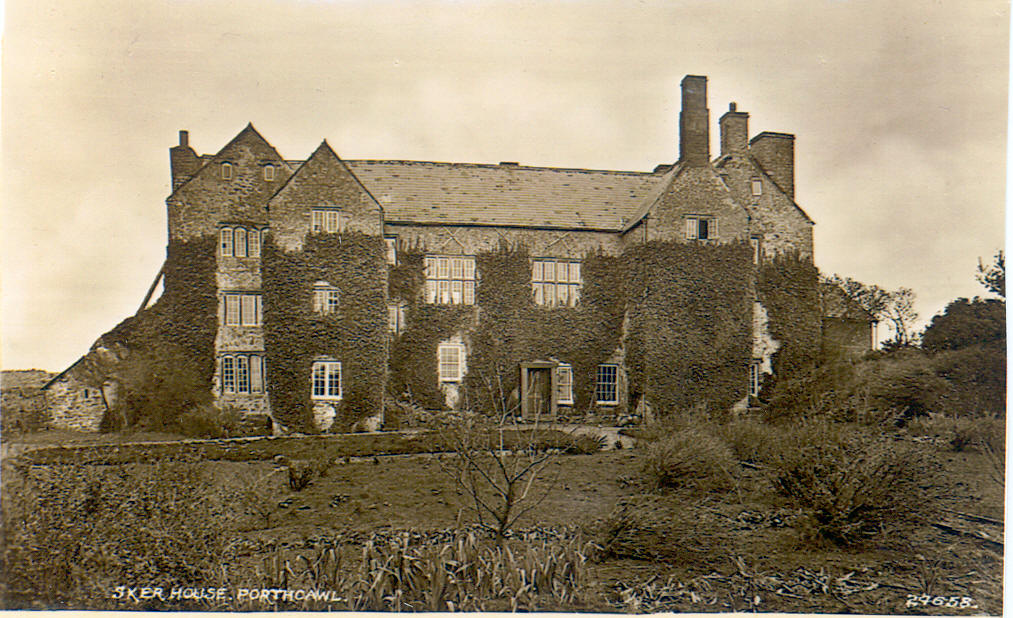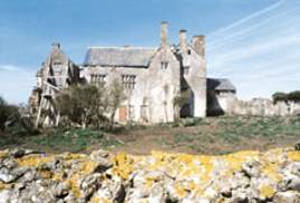

Sker House
Located in near Porthcawl in Mid Glamorgan, is one of the few great houses of the Tudor period to have survived in Wales.
Originally founded by the monks of Neath as one of the ‘granges’ to support the abbey, then remodelled in the 16th century, Sker House has been tenanted since the 17th century. In the 19th century, however, its conditions declined. Declared unsafe in 1977, it had since then been in a ruinous state and its grounds used as a farmyard.
Built by monks on the windswept coast near Porthcawl, Sker House is a rambling, medieval building currently being renovated. It was made famous by Victorian novelist RD Blackmore when he heard a true story about the Maid of Sker - a young woman who was imprisoned there. in a room with blocked up windows.
Arguably one of Wales’ most important historic buildings, Sker House was successfully purchased in this manner by Bridgend County Borough Council and immediately sold to the Buildings at Risk Trust, a BPT based in Derbyshire. (At the time there were no BPTs in the region with the resources to take on a project of this size.) A scheme for the renovation of the building has now been prepared by the specialist conservation architects, Davies Sutton Architecture, of Pontyclun.
Sker House is a large medieval house near Porthcawl in Glamorgan. It was originally founded by the monks of Neath as one of five farms or ‘granges’ to support the Abbey. The main house was remodelled in the mid 16th century following the Dissolution. Architecturally it is large and rambling, with tall gabled wings. Only the main hall on the first floor is more refined, with stone mullioned windows in the Tudor manner and the remnants of a fine plaster frieze of foliage interspersed with bird-headed men shooting arrows at dragons.
Made famous by RD Blackmore in his book The Maid of Sker, Sker House has been
tenanted since the late 17th century. Its condition declined in the 19th century
and in 1977 it was declared unsafe. Not long after its tenants moved out, the
southern gable end collapsed. The building is now in a ruinous state with ugly
farm buildings nearby detracting from its setting, and the grounds are used
as a

History:
Sker House can justifiably claim to be probably the oldest building in the district that is still in use. Its origins lie in the late 12th century when the first buildings were erected here as a grange or farm of Neath Abbey. Elements of this early building that housed the lay brethren who worked the land in the adjoining fields still exist within the fabric of the present structure, and the adjoining barn known as Ty yr Ychan (‘The Ox House’) is also believed to date from this period.
Following the dissolution of the monastery it was acquired by the Turberville family of Penlline. They used it as a convenient estate to house and support junior members of the family, the most notable being Jenkin Turberville who lived here for a decade or more after 1561. The Turbervilles were staunch Roman Catholics, and as persecution of the adherents of the ‘old religion’ increased during the reign of the first Queen Elizabeth, the isolated house became a convenient refuge for fugitive priests and for holding clandestine services.
When Jenkin succeeded his father at Penlline prior to 1575 he spent considerable sums of money having the former grange renovated and enlarged to create the house we see today. He died in 1597 as a result (so it is believed) of rigorous questioning and torture following the discovery of evidence that he had been harbouring Jesuit priests and promoting Catholicism in Glamorgan. Despite this his descendants remained loyal to their faith, and in 1578 Father Phillip Evans, a Jesuit priest, was arrested at Sker and subsequently hung, drawn and quartered after a mockery of a trial at Cardiff. The occupant of the house then was Christopher Turberville who, in the face of increasing persecution for his faith, finally sold the property and sought exile abroad in 1697.
The Sker estate then passed into the hands of absentee landlords and their tenant farmers. Perhaps the most famous of these was Isaac Williams (1727-1766) whose daughter, Elizabeth, passed into legend as “The Maid of Sker”. How much truth there is in this old tale is, and probably always will be, a matter of speculation. It is claimed that she fell in love with a local carpenter and harpist from Nottage named Thomas Evan who composed the song ‘Y Ferch o’r Sker’ in her honour. Her father, however, forbade the match, and having kept Elizabeth imprisoned in the house forced her to marry a Thomas Kirkhouse.
Although the couple had four children, it is claimed to have been a loveless union. To her husband’s fury, every time Thomas Evans was in the vicinity of their home at Briton Ferry Elizabeth would slip out of the house to hear him play, begging him to perform ‘her song’. She died in 1776 after nine years of marriage, and lies buried at Llansamlet. It is only justice to say that descendants claim the story to be a fabrication and that the marriage, although short, was a happy one.
The Victorian novelist R.D. Blackmore , best known for his novel ‘Lorna Doone’, spent much of his childhood at nearby Nottage Court and knew Sker well. Less well known is the fact that he subsequently wrote a novel called ‘The Maid of Sker’ which he felt was the better work, though this was neither the view of contemporary or latter-day critics. Whilst set at Sker, the story it relates has no connection with the one of legend.
Another less well-known ‘Maid of Sker’ lived here at the end of the 18th century. She was Martha, the daughter of Morgan Howells who farmed Sker from about 1772 until about 1797. Her’s is a happier tale than Elizabeth’s for, having fallen in love with a labourer named William David, the couple engineered a successful elopement and, despite being pursued by her father as far as Bristol, were married at St James’ church, Bath, in 1793.
Neglected by both landlord and tenants the gaunt, grey, historic old house gradually slipped into decay, and was finally abandoned to fall into ruin. Happily this was prevented at the eleventh hour by the intervention of an historic buildings trust who (at the time of writing) are in the process of returning it to the condition it was during the heyday of the Turbervilles. Once renovation is completed the building will be sold on the condition that it is opened to the public on a specified number of days in the year.
Haunted House Myths:
The Maid of Sker
Isaac Williams of Sker had 2 daughters, Mary and Elizabeth. Elizabeth (the maid)
was tall, beautiful and loved dancing. She used to wait for the annual Festival
Gwyl Mabsant to come round. The Festival Gwyl Mabsant was to commemorate the
local saint; Saint Mary Magdalen. The celebrations took place in the town hall
of Kenfig. Everyone attended, even the old women who now preferred knitting.
One fateful year the harpist was Thomas Evans of Newton Nottage. He fell in
love immediately with the tall, attractive girl Elizabeth. They made the most
of the evening together and by morning they were lovers.
When Isaac Williams heard of their association, he was furious. After all, he
was a Gentleman farmer and Thomas Evans was a mere carpenter........ no matter
how good his music he was not suitable for his beautiful daughter. Undeterred
the harpist hired a carriage and pair, and stealthily approached Sker House
hoping that Elizabeth would agree to elope. The dogs heard the carriage approach
and quickly the whole house was on alert as candles and lamps were lit. Thomas
quickly retreated into the darkness. Elizabeth was locked in her room and forbidden
to leave the house.
She pined for her lover, time did not heal her broken heart; so Isaac Williams
forced her to marry Mr. Kirkhouse of Neath.
Elizabeth never forgot Thomas Evans, the man she favored which caused constant
arguments between her and her new husband. When Thomas Evans played anywhere
locally Elizabeth would track him down and would meet secretly; only to be discovered
by her husband. Within 9 years of marriage Elizabeth was dead; presumably dying
of a broken heart.
She was buried at Llansamlet. The tombstone that marked her grave has disappeared
and is believed to be still buried somewhere in the graveyard.
How much of this story is true I dont know. The story, first written in Welsh with the tittle "Y Ferch o Scer" is very similar to another legend, "The Maid of Cefn Ydfa". It tells a story of forbidden love between the lowly born Wil Hopcyn and Anne Thomas; the daughter of a well-to-do farmer of Llangynwyd who is also said to have died of a broken heart.
 click
to see cutaway of sker house
click
to see cutaway of sker house 
Sker House - The Saga Continues
The troubled history of Sker House seems set to continue despite starting the
restoration project back in March 1999. Since then the first contractor went
into receivership at the end of that year. The site then lay dormant for three
years whilst legal matters were resolved. The same contractor (under a different
name) was reinstated in November 2002 but suddenly resigned last April. A third
contractor, Restruct Ltd of Bridgend, is now completing the project, which is
programmed to finish in July 2003.
The main structural work was completed three years ago, and the remaining works involve: installing the heating and electrical services, completing the plastering, fitting metal windows and oak plank doors, laying floors, and laying the external drainage. There will also be a measure of external landscaping, such as rebuilding garden walls, and introducing paths around the house. Whilst excavating for drainage recently the archaeologist discovered a series of Medieval(?) structures at the front of the house - probably belonging to the earlier Medieval Grange.
The level of completion of the House has been a topic of discussion for many years. It has been decided to take the project to about 90% completion, leaving the finishing touches to the new owner so they can decide upon the final fit-out. This provides maximum flexibility so the sale of the house will attract as many uses, and therefore buyers, as possible. Covenants will be attached to the sale to ensure that future works will conform to the Trust's wishes.


Sker House as it looks today:

On A Personal Note:
Either the mother or grandmother of Mabel Thurston, who was the mother of Charlotte Mary Thurston, worked at Sker House, probably as a maid or housekeeper. This would be my great-great or great-great-great grandmother.